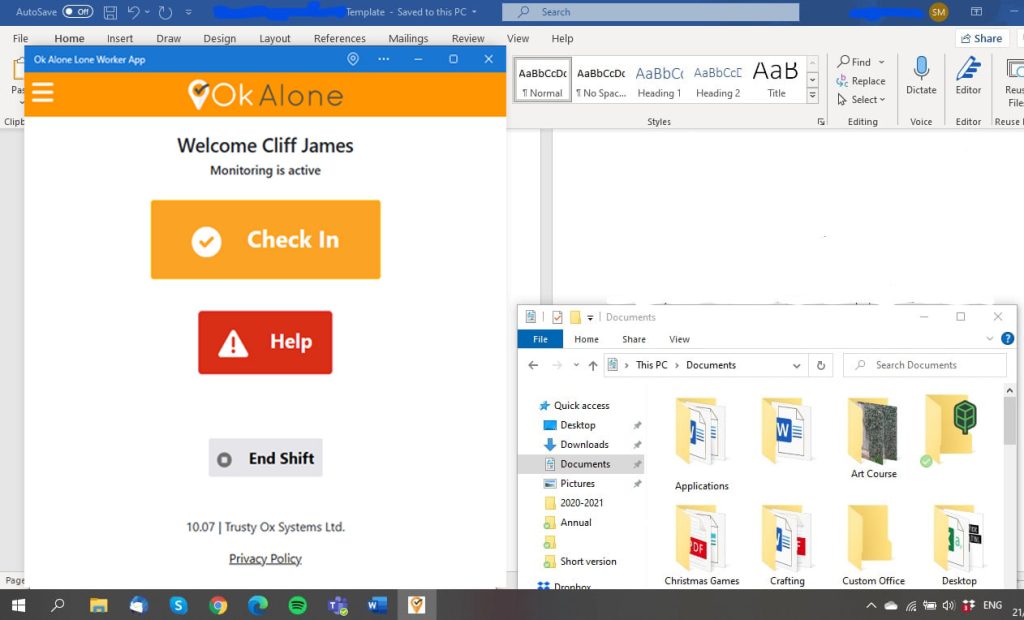Elena works in the office of a small company. One day, while working late, she finds herself in an escalating confrontation with a disgruntled co-worker who becomes increasingly aggressive and verbally abusive. Feeling threatened and concerned for her safety, Elena discreetly activates the panic button on her computer screen.
As soon as the panic button is activated, an alert is immediately sent to designated management personnel. Meanwhile, Elena remains calm and attempts to defuse the situation while keeping a safe distance from her co-worker.
In response to the panic button alert, monitors rapidly review the distress notification on their employee safety monitoring dashboard, using information on personnel to identify the exact location of Elena’s workstation within the office. They immediately initiate the emergency protocol, dispatching security personnel to Elena’s office to provide assistance.

Within minutes, security personnel arrive at Elena’s office, professionally intervening to separate and de-escalate the confrontation. The presence of other people helps diffuse the tense atmosphere, ensuring Elena’s safety and restoring a sense of order.
Following the incident, the company conducts a thorough investigation, reviewing the panic button activation logs and office security camera footage to document the details of the confrontation. This information is valuable for addressing the incident internally, providing support to Elena, and implementing measures to prevent similar situations in the future.
In this example, the computer-based panic button plays a crucial role in helping an office worker like Elena during a confrontation after hours. By discreetly activating the panic button, she initiates an immediate response from her monitors, enabling them to swiftly intervene and ensure her safety. The panic button’s features, such as having her location, empower Elena and provide her with a sense of security.
Benefits of panic button software to office based staff

Here are some ways panic button software can enhance office worker safety:
1. Rapid response:
A computer based panic button enables office workers to quickly notify designated personnel, such as security teams or supervisors/management, about a potential threat or emergency. This immediate response can help minimize the time between the start of an incident and the arrival of assistance, improving overall employee safety.
2. Discreet activation:
Panic buttons can be discreetly activated allowing employees to trigger an alarm without drawing attention to themselves or escalating a situation. This is particularly crucial in situations where alerting others openly may put individuals at further risk.
3. GPS tracking:
Many panic button software solutions include GPS tracking capabilities, which enable responders to pinpoint the exact location of the distress signal. In an office building environment when a help request is activated by a staff member their supervisor is able to see who has requested help. The information box on their Worker info page can have listed what floor and exactly where that person is located.
4. Centralized monitoring and reporting:
Panic button software typically includes a centralized monitoring system that allows designated personnel to receive and manage distress signals efficiently. This can be through a call-centre or supervisors and managers in-house. This approach ensures that alerts are not missed or overlooked, and appropriate actions can be taken promptly by the correct people.
Conclusion
In conclusion, the scenario described above highlights the vital role that a computer-based panic button can play in ensuring the safety and well-being of lone office workers during confrontations. The incident involving Elena demonstrates the effectiveness of this technology in providing immediate assistance, discreetly alerting support, and facilitating communication in critical situations. By empowering employees to activate the panic button, companies can proactively address potential threats and swiftly respond to emergencies.
Implementing such panic button systems underscores a commitment to employee safety, fostering a secure work environment where individuals can feel protected and supported. As companies continue to prioritize the well-being of their workforce, integrating computer-based panic buttons into office settings becomes an essential step towards creating a safer and more respectful workplace for all.

As an expert in lone worker content management, I possess an extensive knowledge base and experience in the area of lone working and safety monitoring. My expertise in this field encompasses a wide range of areas, including risk assessment, training, communication, and technology. I have a deep understanding of the unique risks associated with lone workers and have researched and written many projects and articles to educate people in how to mitigate these risks.
Throughout my time with Ok Alone, I have kept up to date with technological developments, legislative changes and regulations that have been introduced to help organizations ensure the safety of their lone workers.

